eLearning Project Management: Project Plan Template and Tools

Being an eLearning professional can feel like a delicate balancing act while juggling many balls. From writing and editing to design and development, it takes many hands to get the job done. But even with a talented team, incredible ideas, and the best tools on the market, you won’t get anywhere without a proper project plan and oversight. Now meet eLearning project management – the practice of making sure that every part of the eLearning development process runs synchronously, on time, and to standard!
In this article, we will guide you through the eLearning project management process (including the course development project plan template), and explain why it’s important.
What Is an eLearning Project?
An eLearning project aims to create an engaging and informative online course that helps learners achieve the desired learning outcomes, but this is from a macro perspective. From a micro perspective, an eLearning project involves the effective coordination of your development team to build the course to standard and launch it.
In short, eLearning projects are highly collaborative and multi-functional accomplishments that often include the following roles:
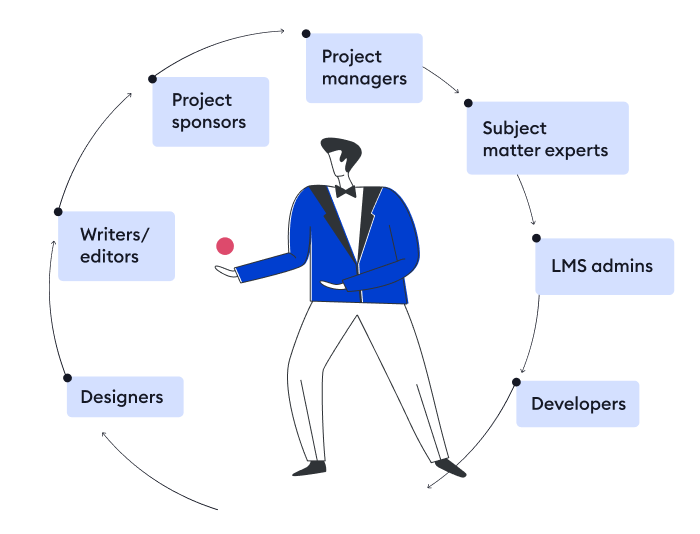
What Is an eLearning Project Plan?
An eLearning project plan is a document that outlines what needs to be done, when, how, and by whom to achieve the final goal, such as launching a training program.
It ensures that the entire team and stakeholders are on the same page about the project’s direction.
Sample eLearning Project Plan Template
Before we dive in, please note that you can download the instructional design project plan template as an Excel spreadsheet now and customize it to your unique business needs.
If you are familiar with the process, just fill in your project details, and this will be your go-to eLearning project plan.
Download for free an instructional design project management template →
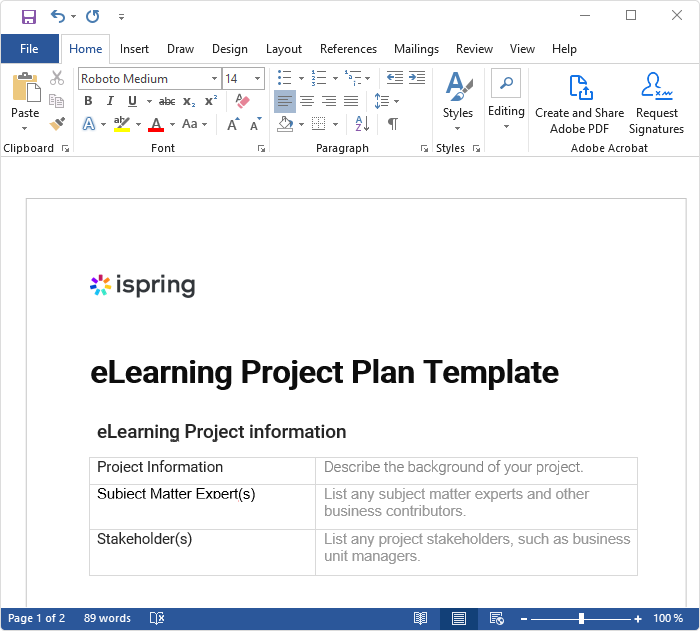
A handy eLearning project plan template by iSpring
For more details, scroll down to the “How to Create an eLearning Project Plan” section for details on creating an eLearning project plan.
eLearning Project Management Process
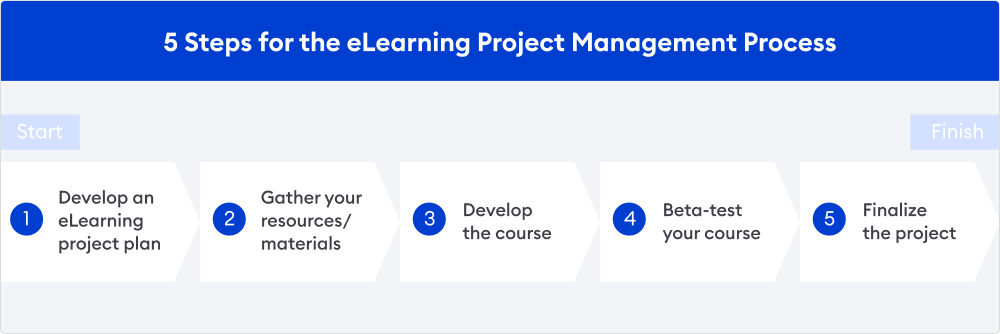
For a smooth project launch, proper planning, realistic goal setting, and using the right eLearning project management tools and methods are essential. Let’s take a deeper look at the entire eLearning project management process.
Pro tip: Use these eLearning process templates to boost your team productivity and ensure consistency of content.
How to create an eLearning project plan
Step 1. Develop an eLearning project plan
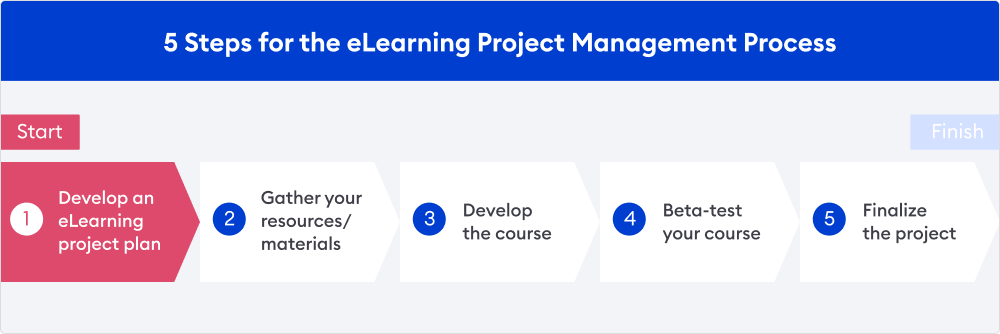
Though this is the first step in the overall eLearning project management process, developing an eLearning project plan is a process unto itself! We’ll briefly outline how to create an instructional design project plan and provide you with a customizable template. This section assumes that you have already conducted a Training Needs Assessment (TNA).
A Training Needs Assessment (TNA) is the method of determining if a training need exists and, if it does, what training is required to fill any gaps. A needs assessment usually includes the following steps:
- Analyzing the present situation
- Defining a business goal
- Identifying the main cause of the training needs
- Determining what employees have to do to achieve the goal
- Finding out why they aren’t doing it
Then, you’ll have all the information you need to begin building your eLearning project plan! Here are the steps:
Define project milestones/deliverables
The ultimate goal of the TNA is to differentiate between what people have and what they need. Once that’s accomplished, you can begin breaking their “needs” down into project deliverables. Simply put, you need to split a large task of developing an eLearning course into smaller steps.
As a result, you’ll have 6 project milestones:
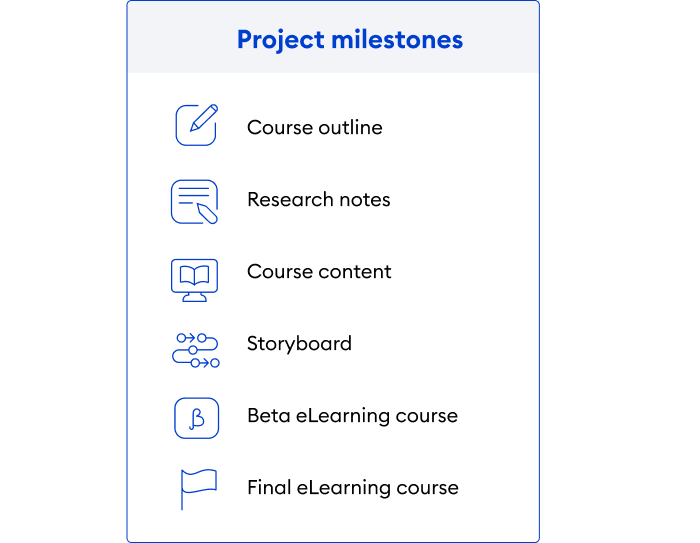
Specify what resources you’ll need for each milestone
After you’ve identified the milestones, you need to decide who will be involved in the process and what eLearning project management tools and resources are required for each task. Take a look at this example of how it might look:
| Milestone | People involved | Tools and resources required |
| 1. Outline research notes | Content writers, SMEs | Internet resources, books |
| 2. Course content | Content writers | Google Docs |
| 3. Storyboard | Instructional designer, graphic designer | Figma, a stock-photo library |
All these things come at a price, so by specifying the resources, you’ll also be able to define an appropriate price. In a sense, you bag two birds with one stone here. Not only does this step enable you to determine and gather everything you’ll need for your project plan, but it also lets you justify the total cost of the project to stakeholders.
Set deadlines for each milestone
Once you know what you need and how much it will cost, you’re well on your way to creating a project schedule. It’s impossible to determine how long the project will take without being able to assess how much time each part of the process requires.
At this point, it’s great to consult with team members from each role about realistic timelines for your project plan. From there, as mentioned, you can create flexible deadlines to compensate for any unforeseen circumstances.
| Milestone | People involved | Tools and resources required | Deadlines |
| 1. Outline research notes | Content writers, SMEs | Internet resources, books | 08.10.24 |
| 2. Course content | Content writers | Google Docs | 08.15.24 |
| 3. Storyboard | Instructional designer, graphic designer | Figma, a stock-photo library | 08.22.24 |
Step 2. Gather your resources/materials
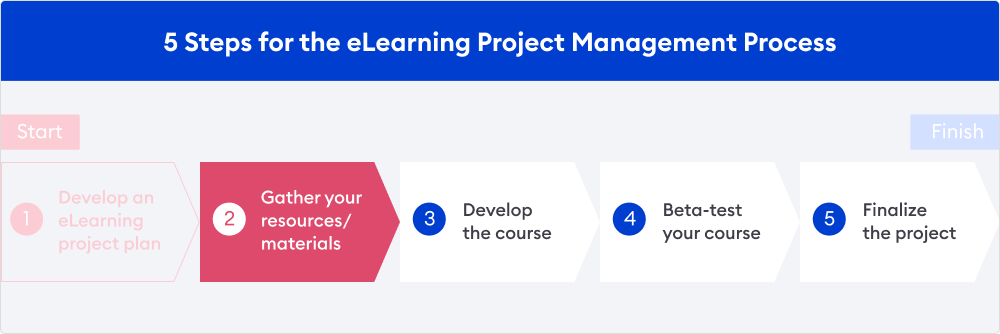
Once the eLearning project plan has been created and you’ve determined your deliverables, you can see all the resources and tools that you’ll need at a glance. As mentioned above, there are two main types of resources you’ll need: human resources and software/tech.
As far as people go, it’s clear that, during the eLearning course design stages, you’ll need stakeholders and a project manager who may or may not also be an instructional designer. Then, during the course development stage, you’ll need some combination of human resources and tech tools. This is where things get particularly sticky.
Between managing stakeholder expectations and ensuring that your writers, designers, voice-over artists, and development team are in working order, you also have to ensure that they have the best tools to perform their roles efficiently. For example:
- The writer may require access to the appropriate sources and editing software.
- The designer might need access to photo libraries and eLearning assets.
- The voice-over artist may require a professional microphone and editing software.
- The developer may need the right authoring tool for putting an eLearning course together.
From an eLearning project management perspective, both sourcing and managing these many resources can be costly and cumbersome. Fortunately, you can cut course development costs significantly and easily streamline this step with the right authoring tool.
Authoring tools offer a comprehensive tech stack essential for course development, enabling centralized content creation and minimizing the need for specific human resources.
There are many great, one-stop-shop solutions that allow people with minimal technological know-how to create professional courses effortlessly. iSpring Suite AI is among them.
Anyone who can use PowerPoint can use iSpring Suite because it’s neatly embedded, as a tab, at the top of the interface. Navigating the software should be a breeze!
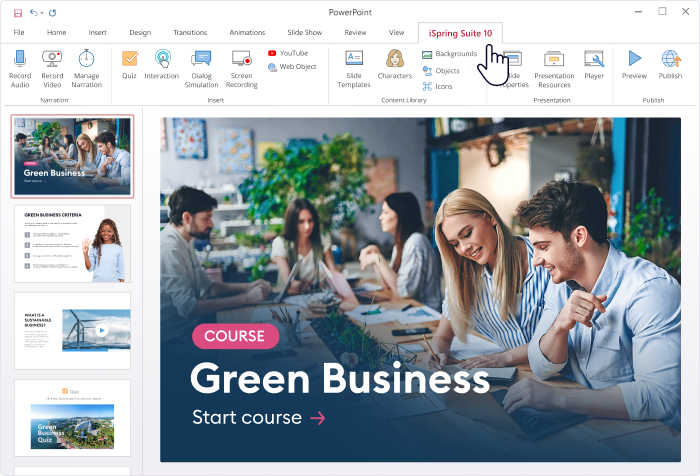
As you can see in the image above, you have all the resources you need at a glance. No voice-over artist or external software is needed to edit or record professional audio or videos. There’s also a dialogue simulator and a wide variety of interactions and quiz types right out of the box.
There’s no need to pay for a savvy programmer to bring your eLearning course to life. In fact, you don’t even need to hire a designer for a professional-looking course with quality visuals, because iSpring Suite AI comes with a built-in content library.
Apart from authoring tools, you’ll also need software to deliver courses to your learners. The best way to do this is with a learning management system (LMS) that lets you assign courses to your learners and track their progress.
If you still don’t have an LMS, consider iSpring LMS. With the software, you can publish your eLearning course seamlessly, without hiring an LMS admin or pro to tediously transfer everything. As it’s integrated with the iSpring Suite authoring toolkit, it delivers your course flawlessly, without compromising any interactive or sophisticated features that you’ve incorporated.
So, in essence, with the right resources, you might only need to hire a single developer during the next phase of the eLearning project management process – development.
Step 3. Develop the course
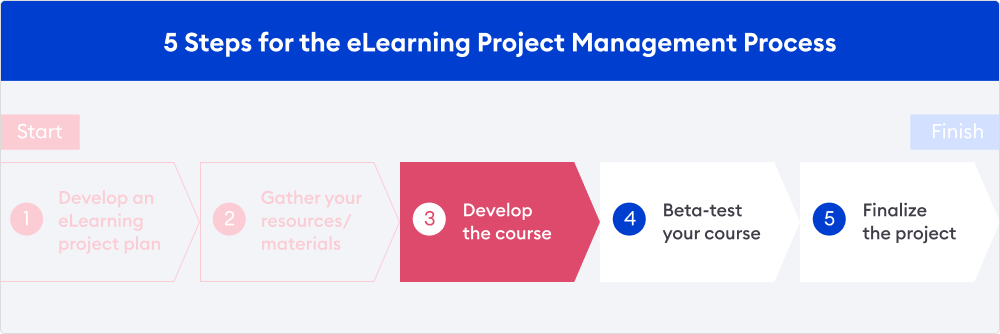
Whether you choose to hire help or streamline course development with key eLearning authoring tools, this step is where most of the action happens. It’s also where most things go wrong, including extending deadlines and going over budget.
So, here, you’ll need to stay on top of everything while simultaneously taking a step back. It’s now your team’s responsibility to construct the deliverables and present them to stakeholders. And your role, as someone who liaises closely with the stakeholders, is to catch any hiccups early on and get the team back on track.
Thus, in keeping with our sample eLearning project plan, the first part of project execution is initiating it. It’s quite customary for project managers to host kickoff meetings involving both stakeholders and the production team.
Once everyone knows who’s doing what, you can encourage the team members to ask questions, discuss deadlines, and ensure that everyone’s on the same page.
The rest of the eLearning project, from writing the outline to launching the course, involves managing the people, processes, and communication to ensure that everything occurs on time, within budget, and to standard. For example:
- Did the subject matter experts provide enough support and feedback for the writer’s content?
- Did the instructional designer create the content storyboard for the beta eLearning course?
- Did the stakeholders provide the branding information needed for the designer to create the visuals?
- Is everything that the eLearning developers created functional?
- Is everyone performing their roles on time and to standard?
- Are we conducting enough meetings to ensure that everyone’s on the same page?
This naturally requires some back-and-forth movement between the stakeholders and the production team. This is especially true since your team created the first (beta) version of the course. At this point, the project manager presents the draft to the stakeholders for feedback. Once the production team has successfully incorporated this feedback, the course is ready for pilot implementation!
Step 4. Beta-test your course
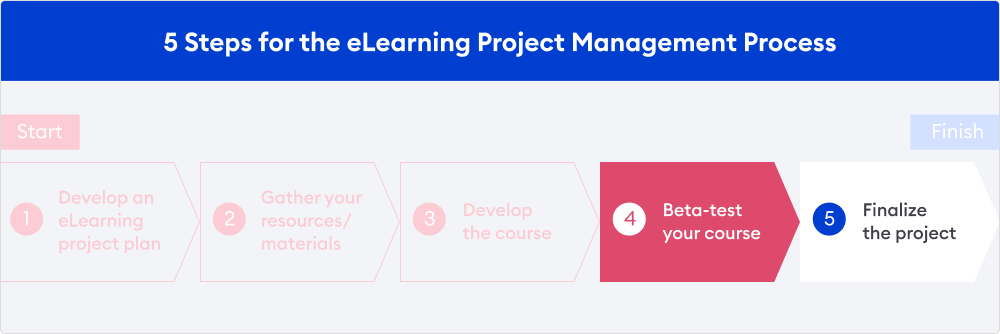
At this stage in the eLearning project management process, you test your beta course. Many eLearning project managers make the mistake of skipping over this step and launching the course. But there’s nothing better than having a fresh pair of eyes on the project prior to a full rollout.
In essence, the project manager organizes a trial run by assembling a group of learners that reflects the target audience demographics.
These “test learners” go through the entire eLearning process, providing feedback on the content, achieving learning goals, technological issues (like browser incompatibility), and overall user experience. Because they’re first-time viewers, they’re more likely to catch any bugs or glitches, enabling you to fix them before the course is officially launched.
To conduct beta testing, the project manager needs to:
- Develop questions to ask the test users.
- Determine which test users best reflect your target audience (while still ensuring diversity).
- Figure out the ideal sample size (you don’t want the number of testers to be too small, but too many can lead to redundancy).
- Choose a location that closely reflects the typical learning environment (e.g., should testers take the course at home or at the office?).
Step 5. Finalize the project
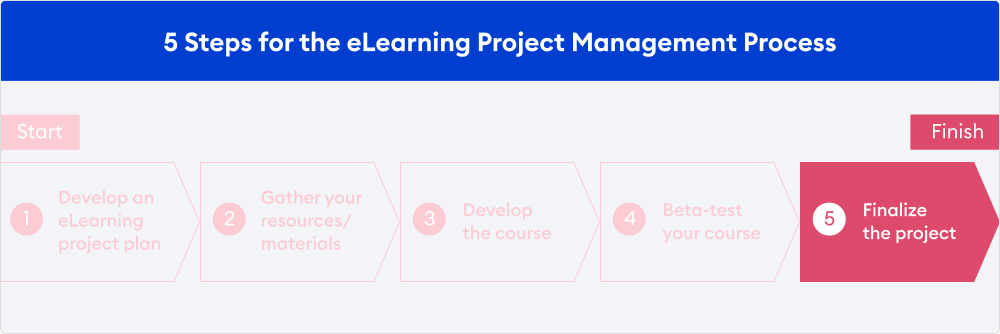
The hardest part is over. But some final quality assurance measures need to be taken. First, apply important feedback from the testing phase before giving the deliverables to the project stakeholders.
During this stage, verify if everything’s been completed to satisfaction. This can occur during a project close-out meeting, where you both celebrate your wins and discuss what can be improved upon in the future. As such, all team members should attend the meeting, since everyone can gain from hearing each other’s perspective. By the time you complete this meeting, you’re ready to officially distribute/launch your final eLearning course!
Also read → 30 Best eLearning Examples to Inspire You
eLearning Project Management Tools
The project management software market is saturated, so you might not know where to start. In this section, we’ll highlight 5 awesome eLearning project management tools to start you off on the right foot!
1. Slack
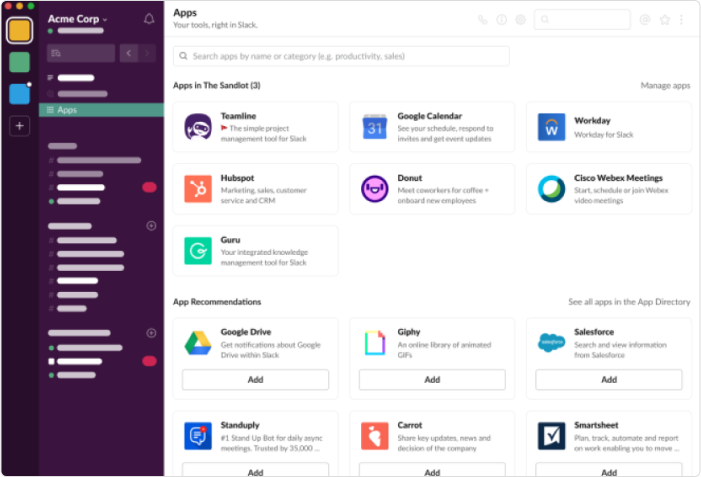
Slack is one of the most common eLearning project management tools, given its coverage and ease of use. The team collaboration tool supports instant messaging, audio and video calls, and task management, and makes file sharing a breeze. Another core feature is its Slack channels, an easy way to organize your workspace into groups! You can organize your entire eLearning project team by role/function while keeping “channels” open to everyone.
Cost: $0 (Basic), $7.25 (Pro), and $12.50 (Business) per active user/month, if paid annually.
2. Trello
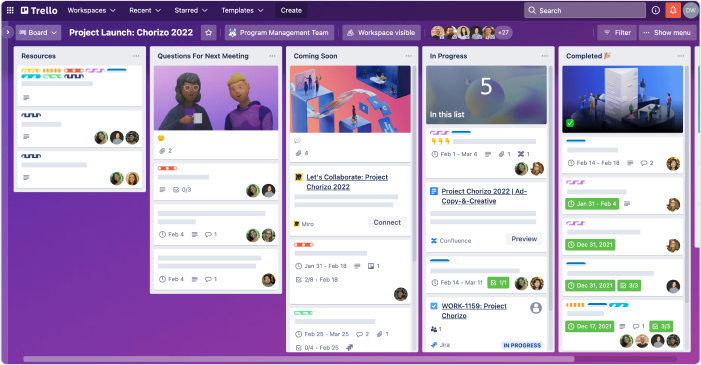
Unlike Slack, with Trello, your eLearning project team can see all eLearning project tasks at once.
The eLearning project management tool organizes things into cards and rows. Each card represents a project phase (e.g., beginning, middle, and end).
Within each card, there are small rows that represent tasks associated with each deliverable (e.g., course outline, written content).
Project phases can be rearranged easily with a drag-and-drop feature; the idea is to slide the tasks into each phase to see what has and hasn’t been done.
That said, given its linear functionality, it might not be the most efficient choice due to the iterative nature of eLearning.
Cost: Free plan, $5 (Standard), $10 (Premium), and $17.5 (Enterprise) per user/month, if paid annually.
3. Asana
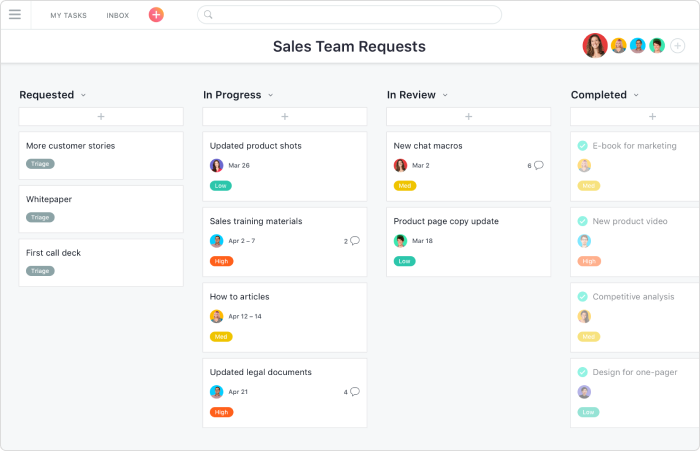
Asana is another eLearning project management tool that helps teams plan, manage, and even automate their work. One feature that sets it apart is its many view modes. You can easily view all tasks in a list, timeline, or calendar. And because the status reports virtually build themselves, you can keep stakeholders up to date without lifting a finger.
Asana’s Smart Answers AI feature (looks like a chat bot) allows you to ask any questions about your project.
That said, like Trello, it does not support video or audio conference calls without third-party integrations. So, you’ll need additional setup if you’re working with distributed teams.
Cost: $0 (Personal), $10.99 (Starter), $24.99 (Advanced) per user/month, if paid annually.
4. Wrike
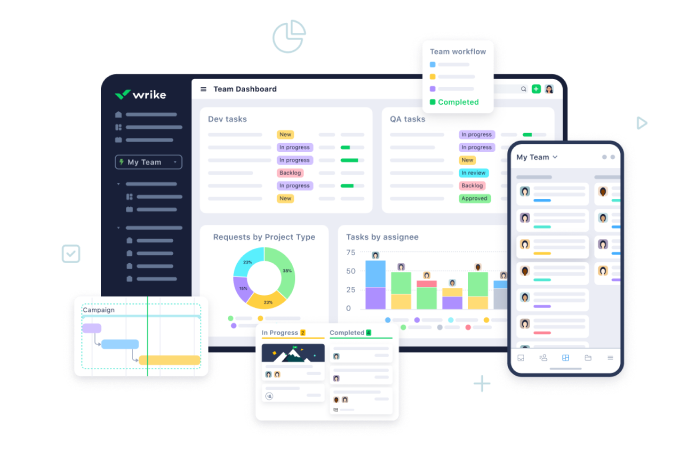
Built for bigger teams, Wrike enables many impressive features for end-to-end project management. Unlike many other eLearning project management software that’s organized based on an eLearning project plan, Wrike actually assists with the project conception stages.
Not only does it feature a Gantt Chart, which serves as a visual timeline for effortless stage tracking, but it also comes with customizable dashboards, workflows, and groups for your unique project needs.
In 2023, Wrike released automation options and even AI suggestions for automation. This advanced feature spots repetitive processes within your daily or weekly routines and offers relevant automation templates.
Wrike has third-party integration with 43+ apps, including Zoom, Microsoft Teams, Slack, and Gmail. So, you can bypass any communication hurdles that can arise with large and/or distributed teams.
Cost: Free plan, $9.80 (Team), $24.80 (Business) per user/month.
5. Basecamp
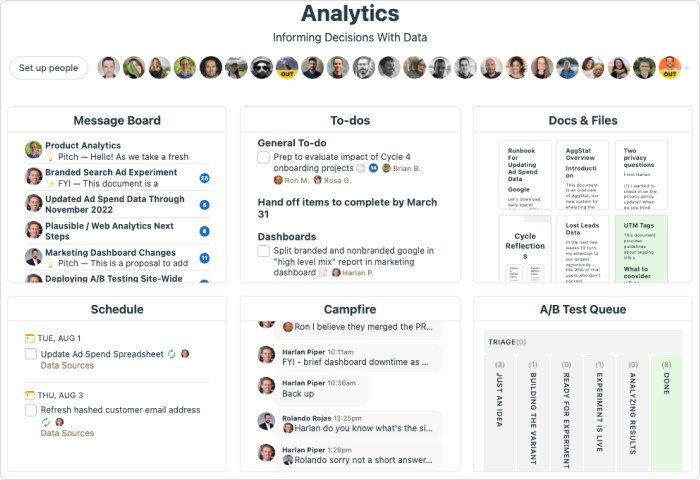
Basecamp is a user-friendly and highly social collaboration tool. As with many other eLearning project management software, there are discussion boards and chat rooms for your development team to huddle together, come up with ideas, and solve issues.
A major differentiator is the user interface. Basecamp organizes project details into “camps.” For example, you might have a camp that focuses on to-dos and project scheduling, or one that’s just for hosting documents and files.
Basecamp offers integrations with time-tracking and reporting tools, but there are no audio/video conferencing options.
Cost: No free plan, but a 30-day free trial. There is a plan for $15 per user/month or $299 (unlimited number of users) per month.
Typical Obstacles for eLearning Project Teams and How to Overcome Them
Collaborative work is great and can be highly rewarding. But the more people with their hands in the pot, the greater the chances for communication breakdowns, differing opinions, conflicting schedules, late submissions, etc. Like a link in a chain, each connection point or node is a potential bottleneck that can throw off the entire developmental process. That’s why eLearning project management is essential. An L&D department might face the following challenges:
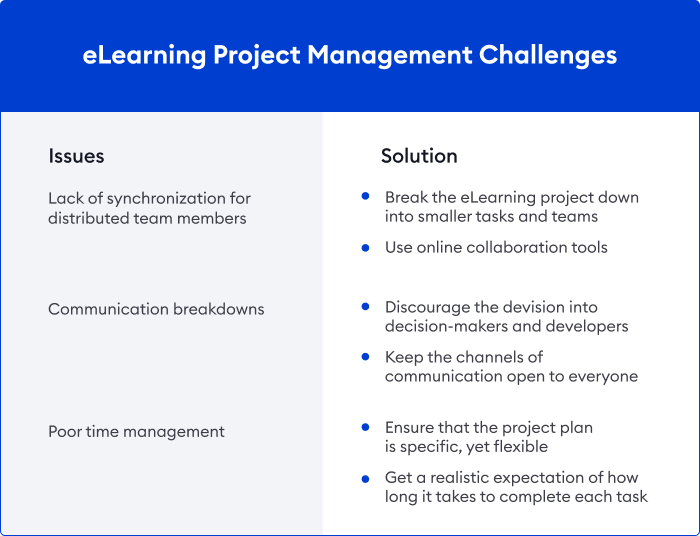
1. Lack of synchronization for distributed team members
To attract top talent, sometimes you need to source them from afar. But managing remote-collaboration teams can pose challenges with scheduling and time zones. Of course, you can always schedule conference calls and Zoom meetings, but ensuring that these meetings are structured and accessible to all is key to project success. An alternative would be to send regular emails and messages, but that can also prove cumbersome.
How to overcome it
- Break eLearning projects down into smaller tasks and teams. For example, the designers don’t need to sit through a writing review, and vice versa.
- Use online collaboration tools like Slack, Asana, or even eLearning-specific tools like zipBoard. These are not only great for file-sharing but also allow teams from various divisions to view everything at a glance.
2. Communication breakdowns
A typical eLearning project team has a top-down hierarchy with stakeholders, project managers, and subject matter experts up top, and production teams underneath. In simpler terms, there are the decision-makers and the developers.
During a trickle-down flow of information, production teams might misinterpret instructions and disseminate this version amongst themselves. Or, they might make assumptions (e.g., they’ll take care of that), which can lead to chaos and missed deadlines.
How to overcome it
- Reduce the division into decision-makers and developers, and work more collaboratively.
- Keep the communication channels open to everyone. Let all parties ask questions and express ideas to each other.
3. Poor time management
The eLearning project manager is responsible for creating a well-defined eLearning project plan. Without clear milestones and corresponding deadlines, it can be difficult to measure your overall progress. Besides, eLearning projects have unique challenges because every role is highly collaborative and closely connected.
For example, the designers depend on the content writers, while the eLearning developers depend on both of these. So, this can create many bottlenecks, not to mention the chaos that can ensue from scope creep, cumbersome revisions, or project overhauls.
How to overcome it
- Ensure that the eLearning project plan is specific, yet flexible. Any deadlines you set should allow for potential delays.
- Get a realistic expectation of how long it takes to complete each task. Consult with each team member before creating the eLearning project plan. Unrealistic goals and deadlines are also time-management killers.
Final Thoughts
eLearning project management requires coordinating various elements, similar to an orchestra. If one part is out of sync, it can affect the entire project. Success hinges on the instructional designer’s or project manager’s skill to keep everything aligned and quickly address any issues that may arise.
This process can be streamlined with the right techniques and tools that help save time. Aside from project management software, consider iSpring Suite, a user-friendly authoring tool that lets your team create courses with no technical skills needed. It offers a free 14-day trial without requiring a credit card or any commitment.



